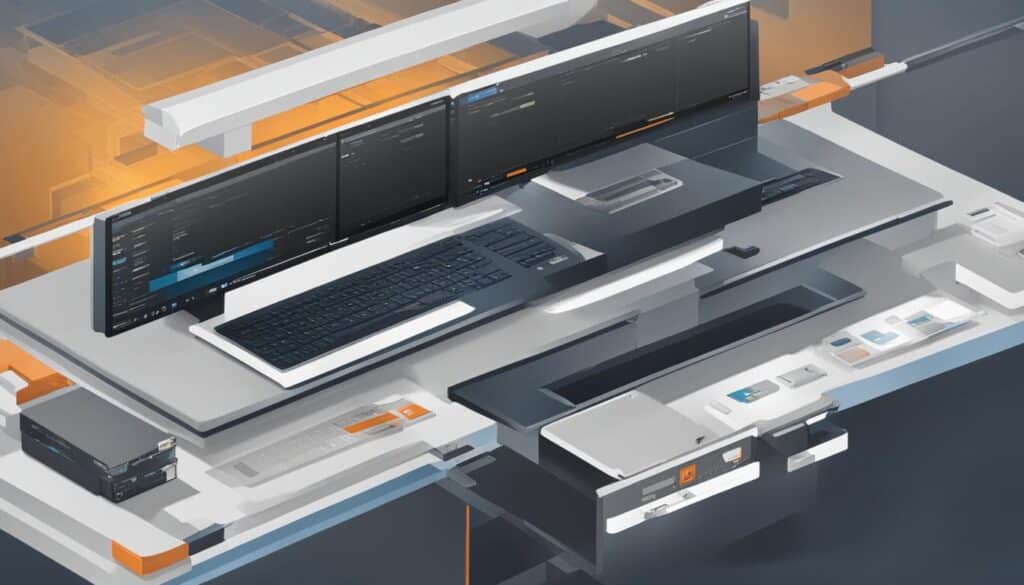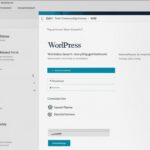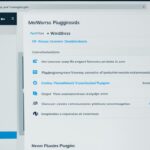Table of Contents
Welcome to our easy WordPress install guide! If you’re looking to build your own website or start a blog, WordPress is a popular and user-friendly platform to consider. In this guide, we will walk you through the step-by-step process of installing WordPress, so you can get your website up and running quickly and easily.
Whether you’re a beginner or an experienced user, this easy WordPress install guide will provide you with multiple methods to install WordPress, catering to different hosting providers and personal preferences. We’ll cover everything from choosing a host with pre-installed WordPress to installing it manually via FTP.
Installing WordPress doesn’t have to be complicated or time-consuming. Our guide will help you find the easiest way to install WordPress that suits your needs. So, let’s get started and bring your website to life with WordPress!
Choose a Host with Pre-Installed WordPress
When it comes to installing WordPress, the easiest and most convenient way is to choose a web hosting provider that offers pre-installed WordPress. With this option, you can skip the hassle of manual installation and get started with building your WordPress site right away.
Two highly recommended hosts that offer pre-installed WordPress are Bluehost and SiteGround. Both of these hosting providers make it simple for beginners to set up their WordPress website without any technical knowledge or complicated installation procedures.
By signing up for a hosting account with Bluehost or SiteGround, you can take advantage of their one-click WordPress installation feature. This means that as soon as your hosting account is activated, you can start building your website without having to worry about manually installing WordPress.
Choosing a host with pre-installed WordPress eliminates the need to navigate through complex installation processes, saving you time and effort. It’s the perfect solution for those who are new to WordPress or simply want a hassle-free experience.
“By choosing a host with pre-installed WordPress, you can focus on creating and customizing your website instead of dealing with the technical aspects of installation.”
Whether you’re a blogger, business owner, or freelancer, opting for a host with pre-installed WordPress makes it incredibly easy to get your website up and running quickly. With just a few simple clicks, you can have a fully functional WordPress site that is ready for customization.
“Say goodbye to the complexities of manual installation and hello to the convenience of pre-installed WordPress with these reputable hosting providers.”
So why wait? Choose a host with pre-installed WordPress today and experience the easiest way to install WordPress, allowing you to focus on what matters most – building and managing your website.
Install WordPress via cPanel and Autoinstallers
If your hosting provider uses cPanel, installing WordPress becomes even easier with the help of autoinstallers. Autoinstallers such as Softaculous, Fantastico, or QuickInstall streamline the installation process, allowing you to set up your WordPress site with just a few clicks.
To install WordPress via cPanel and autoinstallers, follow these simple steps:
- Login to your cPanel dashboard.
- Locate the autoinstaller section. This may vary depending on your hosting provider, but it is typically found under the “Software” or “Website” section.
- Choose the WordPress option from the available list of applications.
- Click on the “Install” or “Setup” button to initiate the installation process.
- Follow the prompts and provide the necessary information, such as the domain or subdomain where you want to install WordPress and the desired administrator username and password.
- Once you have completed all the required fields, click on the “Install” button to begin the installation.
- Wait for the autoinstaller to complete the installation process. This may take a few moments.
- Once the installation is successful, you will receive a notification or confirmation message.
- You can now access your newly installed WordPress site by entering the domain or subdomain in your web browser.
Using autoinstallers via cPanel not only saves you time and effort but also ensures a smooth and hassle-free installation process. Whether you are a beginner or an experienced user, this method simplifies the setup of your WordPress site.
Comparison: Autoinstallers for WordPress Installation
In the table below, we outline some popular autoinstallers commonly used for WordPress installation via cPanel. These autoinstallers offer similar functionality, but there may be slight differences in features and user interface.
| Autoinstaller | Key Features |
|---|---|
| Softaculous | One-click installation, automatic updates, backup and restore functionality, extensive library of scripts and applications. |
| Fantastico | Easy installation wizard, popular applications and scripts, backup and restore options, integrated support and documentation. |
| QuickInstall | User-friendly interface, quick and efficient installation process, automated updates, support for multiple applications. |
Note: The table provides general information and features. It is always recommended to refer to your hosting provider’s documentation for specific details on autoinstallers available through cPanel.

By leveraging the power of cPanel and autoinstallers, you can effortlessly set up your WordPress site without any technical knowledge. Explore the different options available, choose the autoinstaller that suits your needs, and create your WordPress website in no time.
Install WordPress Manually via FTP
Manual installation of WordPress via FTP is a more advanced method but gives you more control over the process. By following these steps, you can install WordPress on your server:
- Download WordPress: Visit wordpress.org and download the latest version of WordPress.
- Create a Database: Log in to your website’s hosting control panel and create a new database. Make a note of the database name, username, and password as you will need these later.
- Configure wp-config.php: Locate the downloaded WordPress files and open the
wp-config-sample.phpfile. Rename it towp-config.phpand open it in a text editor. Fill in the database details you obtained earlier in the following lines:
define( 'DB_NAME', 'database_name_here' ); define( 'DB_USER', 'username_here' ); define( 'DB_PASSWORD', 'password_here' );
- Upload WordPress Files: Use an FTP client like FileZilla to connect to your server. Navigate to your website’s root directory and upload the entire WordPress folder.
- Installation: Once the upload is complete, access your website’s URL in a web browser. Follow the on-screen instructions to complete the WordPress installation.
This method requires some technical knowledge, but it gives you complete control over the installation process. Take a look at the visual representation below for a step-by-step guide:
| Pros | Cons |
|---|---|
|
|
Install WordPress on Your Own Computer
If you want to set up a local WordPress installation for development or testing purposes, you can install WordPress on your own computer. This method allows you to work on your website offline before publishing it online. Follow the steps below to get started:
-
Install a Local Server Environment: Start by installing a local server environment like XAMPP or WampServer. These software packages provide the necessary infrastructure for running WordPress on your computer.
-
Create a Database: Once you have a local server environment set up, create a new database for your WordPress installation. This acts as a storage space for all your website’s data.
-
Download and Configure WordPress: Visit the official WordPress website and download the latest version of WordPress. Extract the downloaded files and configure the wp-config.php file to connect your WordPress installation to the database you created in the previous step.
-
Upload WordPress Files: Using an FTP client like FileZilla, connect to your local server and upload the WordPress files to the appropriate directory. This step ensures that all the necessary files are in place for your local WordPress installation.
Benefits of a Local WordPress Installation
Setting up a local WordPress installation offers several benefits:
- Development and Testing: You can use a local installation to test new themes, plugins, or website changes without affecting your live site. This allows you to experiment and make modifications before implementing them on your actual website.
- Offline Work: With a local WordPress installation, you can work on your website even when you don’t have an internet connection. This is especially useful if you’re frequently on the move or in areas with limited internet access.
- Increased Privacy and Security: Since your local WordPress installation is not accessible to the public, it provides an added layer of privacy and security. You can freely experiment and make changes without worrying about potential vulnerabilities or outside interference.
By following these steps, you can easily set up a local WordPress installation on your own computer. Enjoy the flexibility and convenience of working offline while building and perfecting your WordPress website.
Tips and Next Steps After WordPress Installation
After successfully installing WordPress, there are a few important steps to take to ensure a smooth and successful launch of your website. Here are some tips on what to do after installing WordPress:
1. Set up Permalinks
Permalinks determine the structure of your website’s URLs. It is important to set them up correctly for better search engine optimization and user-friendly navigation. In WordPress, you can configure permalinks by going to Settings > Permalinks and choosing a structure that best fits your website’s content and goals.
2. Configure Essential Settings
Take some time to explore and configure essential settings in your WordPress dashboard. These settings include site title, tagline, time zone, comment moderation, and more. Customizing these settings will ensure that your website operates according to your preferences and provides the best user experience.
3. Choose a Theme
WordPress offers a wide range of themes to choose from, allowing you to customize the appearance and functionality of your website. Browse through the available themes by going to Appearance > Themes in your dashboard. You can preview and activate themes that suit your brand and design preferences.
4. Install Plugins
Plugins expand the functionality of your WordPress website. From contact forms to search engine optimization tools, there are countless plugins available to enhance your site’s features. Take a look at the Plugins > Add New section in your dashboard to explore and install plugins that meet your specific needs.
5. Create Your First Content
Now that you have your theme and essential settings in place, it’s time to start creating your first content. Whether you’re writing blog posts, creating pages, or adding images, WordPress provides a user-friendly content editor to help you bring your vision to life. Simply go to Posts > Add New or Pages > Add New to start crafting your content.
6. Regularly Update WordPress, Themes, and Plugins
WordPress, themes, and plugins receive regular updates to improve performance, fix bugs, and enhance security. It is crucial to keep your WordPress installation up to date by regularly checking for updates and applying them. This ensures that your website remains functional, secure, and optimized for the latest features.
7. Implement Security Measures
Protecting your WordPress website from potential vulnerabilities is essential. Implement security measures such as strong passwords, two-factor authentication, and security plugins. These measures help safeguard your website from malicious attacks, ensuring the safety and integrity of your data.
By following these tips and taking the necessary steps after installing WordPress, you can set yourself up for success and create a professional, functional, and secure website.
Conclusion
Installing WordPress doesn’t have to be a daunting task. With the help of this easy WordPress install guide, you can confidently set up your own WordPress website. Whether you choose a hosting provider with pre-installed WordPress or prefer to install it manually, the step-by-step instructions provided in this guide will help you get your site up and running in no time.
Remember to regularly update and maintain your WordPress installation to ensure optimal performance and security. Keeping your WordPress core, themes, and plugins up to date is crucial, as updates often include bug fixes, security patches, and new features. Additionally, implementing security measures such as strong passwords, regular backups, and a reliable security plugin can help protect your site from potential vulnerabilities.
By following the guidelines outlined in this WordPress install guide, you can confidently navigate the installation process and start leveraging the power of WordPress to create and manage your website. From choosing a hosting provider to configuring essential settings, choosing a theme, and creating content, you are now equipped with the knowledge to get the most out of your WordPress site. Enjoy the journey of building your online presence with WordPress!
FAQ
How do I install WordPress?
There are several ways to install WordPress, depending on your preference and hosting provider. You can choose a host with pre-installed WordPress, use cPanel and autoinstallers, install it manually via FTP, or install it on your own computer for local development or testing purposes.
Can I choose a web hosting provider with pre-installed WordPress?
Yes, choosing a web hosting provider that offers pre-installed WordPress is the easiest way to install WordPress. Hosts like Bluehost and SiteGround are recommended for this option.
How can I install WordPress via cPanel and autoinstallers?
If your hosting provider uses cPanel, you can use autoinstallers like Softaculous, Fantastico, or QuickInstall. Simply access your cPanel dashboard, locate the autoinstaller, and follow the prompts to install WordPress.
What is the manual installation method via FTP?
Manual installation of WordPress via FTP is a more advanced method that gives you more control. You’ll need to download the latest version of WordPress, create a database, configure the wp-config.php file, and upload the WordPress files to your server using an FTP client like FileZilla.
How can I install WordPress on my own computer?
To install WordPress on your own computer for local development or testing, you’ll need to install a local server environment like XAMPP or WampServer. Once installed, create a database and configure the WordPress files accordingly.
What should I do after successfully installing WordPress?
After installing WordPress, there are a few important steps to take. These include setting up permalinks, configuring essential settings, choosing a theme, installing plugins, and creating your first content. It’s also recommended to regularly update WordPress, themes, and plugins, as well as implement security measures for site protection.












